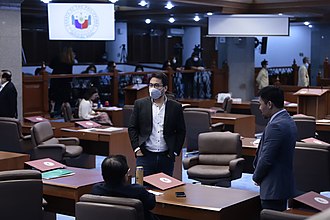Philippine government response to the COVID-19 pandemic
Overview of the Philippine government's response to the COVID-19 pandemic
Overview[edit]
The Philippine government's response to the COVID-19 pandemic involved a series of measures aimed at controlling the spread of the virus, providing healthcare, and mitigating the economic impact of the pandemic. The response was coordinated by the Inter-Agency Task Force for the Management of Emerging Infectious Diseases (IATF-EID), which was established to oversee the implementation of policies and strategies.
Initial Response[edit]

The initial response to the pandemic began in January 2020, when the first cases of COVID-19 were reported in the Philippines. The government quickly implemented travel restrictions, initially targeting travelers from Wuhan, China, where the virus was first detected. As the situation evolved, these restrictions expanded to include other countries with significant outbreaks.
On March 12, 2020, President Rodrigo Duterte addressed the nation, announcing the imposition of a community quarantine in Metro Manila to curb the spread of the virus. This was later expanded to cover the entire island of Luzon, effectively placing it under an enhanced community quarantine (ECQ).
Healthcare Measures[edit]
The government took several steps to bolster the healthcare system's capacity to handle the pandemic. Hospitals were designated as COVID-19 referral centers, and temporary facilities were established to accommodate the surge in patients. The Department of Health (DOH) led efforts to increase testing capacity and ensure the availability of personal protective equipment (PPE) for healthcare workers.

Testing centers were set up across the country, and the government partnered with private laboratories to expand testing capabilities. The Philippine Red Cross played a crucial role in conducting mass testing and providing thermal scanning services.
Economic and Social Measures[edit]
To address the economic impact of the pandemic, the government launched the Social Amelioration Program, which provided financial assistance to low-income families affected by the lockdowns. This program aimed to support the most vulnerable sectors of society during the crisis.

The government also implemented various stimulus packages to support businesses and preserve jobs. These measures included tax relief, low-interest loans, and subsidies for affected industries.
Legislative Actions[edit]
In response to the pandemic, the Philippine Congress passed several laws to provide the government with the necessary tools to combat the crisis. The Bayanihan to Heal as One Act granted the President special powers to reallocate funds and implement measures to address the pandemic effectively.

Subsequent legislation, such as the Bayanihan to Recover as One Act, focused on economic recovery and strengthening the healthcare system.
Public Health Campaigns[edit]
The government launched extensive public health campaigns to educate the public on preventive measures, such as wearing masks, practicing social distancing, and maintaining proper hygiene. These campaigns were disseminated through various media platforms to reach a wide audience.
Vaccination Program[edit]
The Philippine government initiated a nationwide vaccination program to achieve herd immunity and control the spread of COVID-19. Vaccines were procured from multiple sources, including COVAX, and distributed to priority groups such as healthcare workers, the elderly, and individuals with comorbidities.
Challenges and Criticisms[edit]
The government's response faced several challenges, including logistical issues in vaccine distribution, public hesitancy towards vaccination, and the economic strain caused by prolonged lockdowns. Criticisms were also directed at the perceived lack of coordination and transparency in the government's actions.
Related pages[edit]
Ad. Transform your life with W8MD's Budget GLP-1 injections from $75


W8MD offers a medical weight loss program to lose weight in Philadelphia. Our physician-supervised medical weight loss provides:
- Weight loss injections in NYC (generic and brand names):
- Zepbound / Mounjaro, Wegovy / Ozempic, Saxenda
- Most insurances accepted or discounted self-pay rates. We will obtain insurance prior authorizations if needed.
- Generic GLP1 weight loss injections from $75 for the starting dose.
- Also offer prescription weight loss medications including Phentermine, Qsymia, Diethylpropion, Contrave etc.
NYC weight loss doctor appointmentsNYC weight loss doctor appointments
Start your NYC weight loss journey today at our NYC medical weight loss and Philadelphia medical weight loss clinics.
- Call 718-946-5500 to lose weight in NYC or for medical weight loss in Philadelphia 215-676-2334.
- Tags:NYC medical weight loss, Philadelphia lose weight Zepbound NYC, Budget GLP1 weight loss injections, Wegovy Philadelphia, Wegovy NYC, Philadelphia medical weight loss, Brookly weight loss and Wegovy NYC
|
WikiMD's Wellness Encyclopedia |
| Let Food Be Thy Medicine Medicine Thy Food - Hippocrates |
Medical Disclaimer: WikiMD is not a substitute for professional medical advice. The information on WikiMD is provided as an information resource only, may be incorrect, outdated or misleading, and is not to be used or relied on for any diagnostic or treatment purposes. Please consult your health care provider before making any healthcare decisions or for guidance about a specific medical condition. WikiMD expressly disclaims responsibility, and shall have no liability, for any damages, loss, injury, or liability whatsoever suffered as a result of your reliance on the information contained in this site. By visiting this site you agree to the foregoing terms and conditions, which may from time to time be changed or supplemented by WikiMD. If you do not agree to the foregoing terms and conditions, you should not enter or use this site. See full disclaimer.
Credits:Most images are courtesy of Wikimedia commons, and templates, categories Wikipedia, licensed under CC BY SA or similar.
Translate this page: - East Asian
中文,
日本,
한국어,
South Asian
हिन्दी,
தமிழ்,
తెలుగు,
Urdu,
ಕನ್ನಡ,
Southeast Asian
Indonesian,
Vietnamese,
Thai,
မြန်မာဘာသာ,
বাংলা
European
español,
Deutsch,
français,
Greek,
português do Brasil,
polski,
română,
русский,
Nederlands,
norsk,
svenska,
suomi,
Italian
Middle Eastern & African
عربى,
Turkish,
Persian,
Hebrew,
Afrikaans,
isiZulu,
Kiswahili,
Other
Bulgarian,
Hungarian,
Czech,
Swedish,
മലയാളം,
मराठी,
ਪੰਜਾਬੀ,
ગુજરાતી,
Portuguese,
Ukrainian